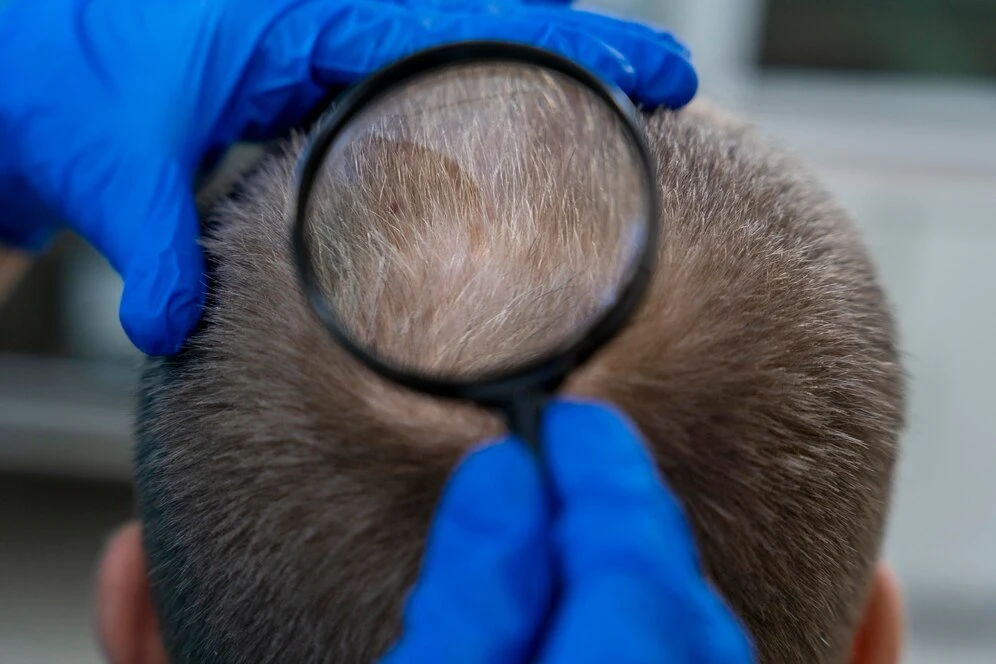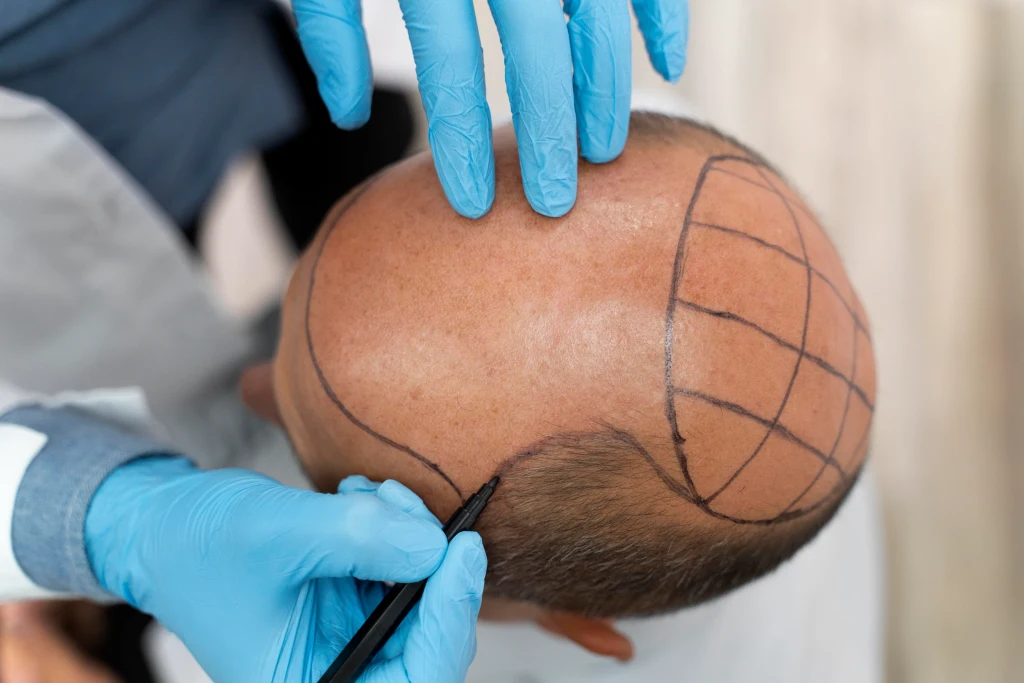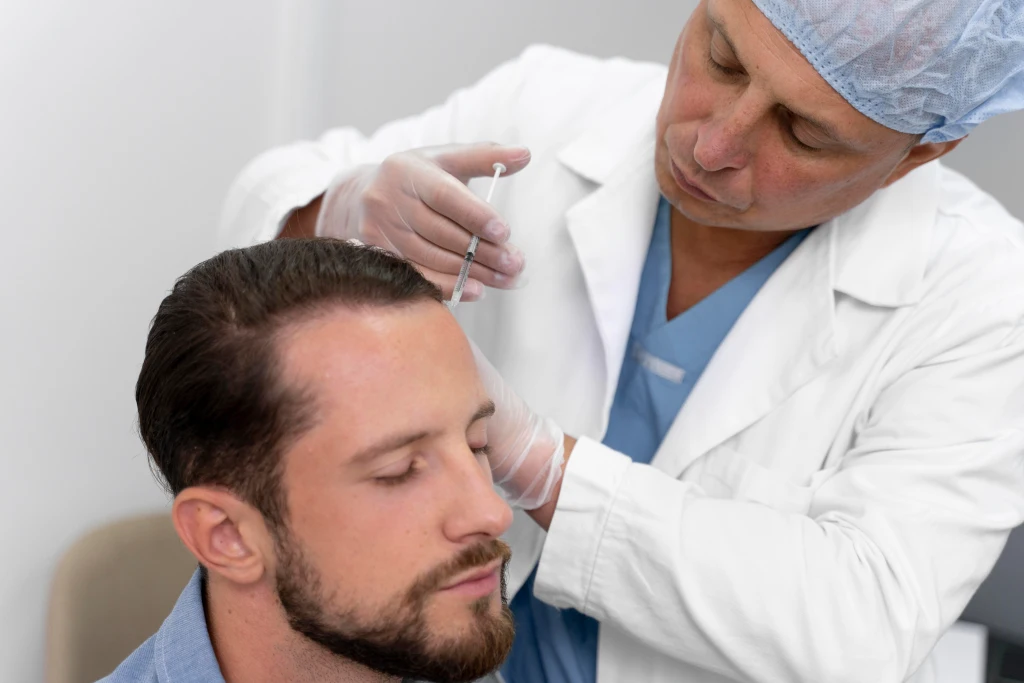Home / Hair Transplant Surgery
Restore Your Hair, Revive Your Self-Esteem
Welcome to Hairsthetics Clinic – your solution for hair loss. If you suffer from androgenetic alopecia, have male pattern baldness, or female pattern hair loss, we have innovative solutions to change your life. At our hair transplantation clinic, we perform Follicular Unit Extraction (FUE) minimally invasive procedure made by board-certified plastic surgeons.

Hair transplantation is a cosmetic surgery procedure aimed at restoring hair growth in areas affected by permanent hair loss.
During hair transplant surgery, hair follicles are moved from a donor site, typically the back of the head, to the bald patches or thinning scalp’s areas, addressing hair loss effectively.
Techniques such as FUE and the strip method are commonly used. This hair restoration surgery can address both female and male pattern hair loss. The Flap surgery can be used in some cases to cover large bald areas.
Transplanted hairs grow naturally, integrating seamlessly with the remaining hair, resulting in a natural appearance and fuller head of hair.
Natural
Results
Modern techniques like FUE mean the transplanted hair blends in with your existing hair, and it's hard to see the difference.
Permanent Solution
Hair transplants are a long term solution to hair loss as the transplanted follicles are resistant to the conditions that cause baldness.
Boost in Confidence
Getting your hair back on bald skin or thinning areas can improve your self-esteem and confidence and impact your personal and professional life.
Low Maintenance
Transplanted hair requires minimal downtime compared to other hair restoration methods, so you can enjoy your natural hair without all the upkeep.
Cost Effective in the Long Run
Although the upfront cost is high, the long-term results of hair transplants can be more cost-effective than ongoing treatments or temporary solutions.
At Hairsthetics Clinic, we want to make the hair restoration process as easy and transparent as possible. Understanding each step is key for our patients to feel comfortable and confident in their decision to get a hair transplant session.

The process starts with an initial consultation at our hair transplant clinic. During this appointment, our doctor will assess your hair loss condition, talk to you about your goals, and determine if you’re a good candidate for hair restoration surgery.
We will review your medical history and do a scalp exam to see the extent of hair loss and the quality of hair plugs your donor area.
Based on the consultation, we will create a personalized treatment plan for you. This plan will outline the recommended hair transplant technique, the number of grafts, and the expected results.

During the consultation, our plastic surgeons will assess your hair loss condition to understand the best course of action. We will consider factors such as:
Your hair type
Family hair loss history
Overall health
Desirable result of hair transplant surgery
This information helps to create the most effective treatment plan.

Before the hair transplantation surgery, you will receive instructions on how to prepare yourself. This may include prescribed medications, dietary restrictions, and post-operative care

On the day of the hair replacement surgery, local anesthesia will be administered to the donor and recipient areas so you will be pain-free. This is a key part to perform hair transplant surgery, so you can relax during the hair replacement procedure.
The FUE combines a few steps:
1. Harvesting Healthy Follicles
FUE hair transplant involves extracting individual hair follicles from the donor area, usually the back or sides of the head, where hair growth is more dense, ensuring the health and viability of each hair follicle. Using advanced technology, our surgeons make tiny incisions to remove the follicles with minimal scarring.
2. Preparation of Grafts
The harvested hair follicles, also known as individual grafts, are then prepared for transplantation. Each graft is examined to make sure it has healthy hair follicles that can produce natural hair growth, ensuring the effectiveness of the transplantation.
3. Hair Transplantation
The prepared grafts are then implanted into the bald or thinning areas of the scalp.
Transplanted hair integrates with the original blood supply for sustained growth.
After the procedure, you will receive instructions on how to care for your transplanted hair. This will include:h
In the weeks following the procedure, the transplanted hair may fall out, which is normal. New hair will start growing a few months later. As the follicles establish themselves in their new location, you will start to see a gradual improvement in hair density and coverage.
Follow-up appointments are scheduled to monitor your progress and address any concerns. We want to make sure your hair restoration results meet your expectations.
We want natural results that blend in with your existing hair. The transplanted hair will grow like your natural hair, so you can style and care for it as usual.
We will provide full support and recommendations on how to keep your new hair healthy and prevent possible future hair loss. This may include:
At Hairsthetics, we use specialized hair transplantation techniques to minimize swelling and ensure a smooth recovery process.
Good candidates for hair transplant surgery include individuals with:
Male pattern baldness
Androgenic alopecia
Thinning hair
Both men and women can benefit from our hair restoration treatments. Candidates should have a sufficient donor area with healthy hair follicles for transplantation.
Hair transplant is generally safe but has some risks and side effects. Common issues are
Swelling
Infection
Bleeding in the donor or recipient areas
Some patients may experience temporary hair thinning, known as "shock loss," which usually resolves within a few weeks.
Numbness or lack of sensation around the treated area can also occur.
In rare cases, allergic reactions to the medicine used during the procedure or severe pain can occur.
That's why it's very important to answer the questions of our surgeon and share all needed information. Having realistic expectations and proper aftercare can minimize these risks to get the desired result.
Hair transplantation is a cosmetic surgical procedure that moves hair follicles from a donor area (the back of the donor site head) to thinning or bald areas of the scalp to grow hair.
During a hair transplant, the follicles of scalp hair are extracted from the donor hair-bearing scalp using FUE method and transplanted to marked areas to grow new hair.
Yes, hair transplants can help with female pattern hair loss by transplanting follicles to pointed bald areas to get fuller hair and confidence back.
Common donor areas are the back of the head, bald scalp, beard hair, and body hair. These areas have follicles that are resistant to permanent hair loss.
After your hair transplant surgery, the hair starts to grow within a few months of the procedure. Full results can be seen after several weeks to months as the hair grows and thickens.
FUE extracts individual follicles with minimal scarring, while FUT extracts a strip of scalp from the donor area and dissects it into grafts, which can leave a linear scar.
Preparation for hair transplant surgery may include avoiding certain medications, taking prescribed vitamin supplements, and following pre-surgery instructions to get optimal results.
Procedure time varies depending on the number of grafts, but most hair transplants take 4 to 8 hours.
